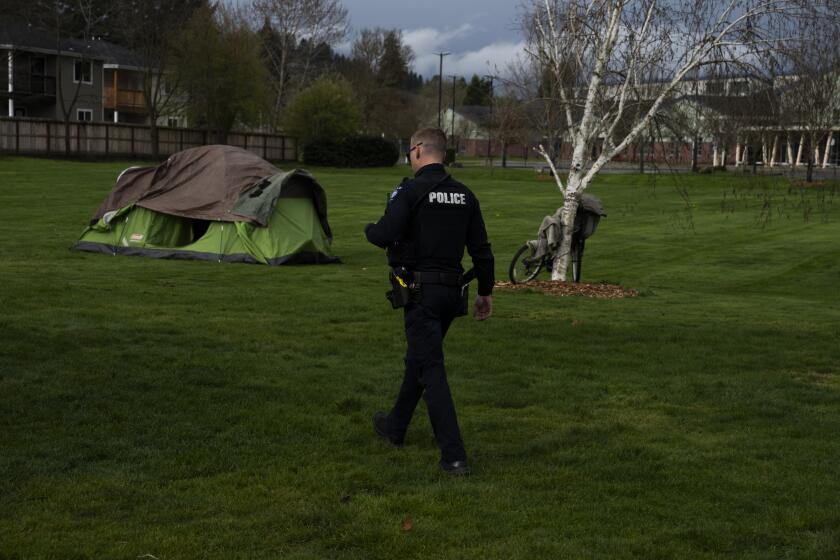Opinion: Why L.A. needs more green space, now
Unlike our world, the human brain has not changed much in thousands of years. Thanks to technology, we no longer live in caves, hide from wild animals or forage for food. Instead, we inhabit sprawling cities, eat what we please and form organizations to protect animals from us. It’s a good gig, except that it comes with hidden costs that are making Los Angeles more dangerous.
It all has to do with green space.
The city is becoming a much denser place. After running out of room to grow out, we’re now growing up. Among modern cities, only Tokyo has grown more in the last 100 years. The collateral damage of this growth is lost green space where our backyards and open space used to be. L.A.’s tree canopy covers 21% of the city, compared with the national average of 27%.
Even before L.A.’s current push toward density, the city was always curiously park poor. L.A.’s Park Score is 46 out of 100, compared with New York City’s 77 -- which puts us 51st nationally while New York is fifth. Forty-one percent of lower-income households in Los Angeles do not have immediate access to a park. In New York, that number is 2%. There is one playground park for every 10,000 people in this city. Imagine 10,000 kids in a park that is, on average, less than seven acres.
But here’s where things get really problematic: recent studies correlate a lack of access to green space with poor health, crime and even domestic violence. The reason is stress.
Faced with decreased air quality, excessive heat from a lack of green space, or mounting anxiety from not having an outdoor space to chill, the brain perceives a threat. This is where the stress response begins. A symphony of hormonal responses follows. Hormones are informational substances -- like various parts of body tweeting each other. When your adrenals get the tweet from the hypothalamus, it releases cortisol to prepare for the eventuality of fight or flight. This triggers a glucose release for immediate energy for the large muscles. Blood pressure and heart rate spike.
But isn’t the modern brain sophisticated enough to compensate for not being able to go for a walk in a park, you ask? Yes, but not in the reptile brain where the stress response is regulated.
The reptile brain’s mantra is: survive now and ask questions later. This is a protective mechanism because if our ancient ancestors heard a suspicious noise, it could very well have been a predator. Or it could have been nothing. Either way, if our ancestor fled, he or she lived to search for dinner. Stop to think about it and they could have become dinner. The reptile brain cannot distinguish between real and perceived threat, and automatically prepares for the eventuality of fight or flight. If it constantly perceives a threat it becomes hypervigilant, which impairs perception. This is the most probable explanation for the recent studies correlating a lack of green space to crime and domestic violence. The old brain is responding to threat with one of the two buttons on its dial -- runaway or attack.
Nowadays, the reason we don’t always run away or attack when things get stressful is that the new, thinking part of the brain exercises impulse control on the reptile brain. However, it needs serotonin, a neurochemical and neurotransmitter that carry signals via nerves cells -- a primary way our brain communicates internally.
Think of serotonin as a cellphone battery. Everyday stress, plus stress imposed by park-poorness and an inadequate tree canopy, drains power. As the battery gets lower, the reptile brain has less access to impulse control. When our battery completely shuts off, we become a version of our hypervigilant, cave person ancestors — with aggressive tendencies but no impulse control and a distorted perception of threat. One minute, we’re drinking lattes and living the dream; the next minute we’re on the news -- “Grizzly details at ten.”
As Los Angeles continues to grow, we’re creating a human-centric city that is ironically too complex for the human brain. Building more green spaces isn’t a cure-all for L.A.’s rising violence and crime, but it could decrease the psychological elements that lead to violent behavior.
Billi Gordon is a neuroscientist at the Ingestive Behaviors and Obesity Program at the Oppenheimer Center for the Neurobiology of Stress at UCLA. Follow him on Twitter @drbillyg.
Follow the Opinion section on Twitter @latimesopinion and Facebook
More to Read
A cure for the common opinion
Get thought-provoking perspectives with our weekly newsletter.
You may occasionally receive promotional content from the Los Angeles Times.






